Mapping and Analyzing Winter Wheat Yields in the Huang-Huai-Hai Plain: A Climate-Independent Perspective
Abstract
1. Introduction
- (1)
- To establish a method for deriving winter wheat yields that are independent of environmental variables, thereby enabling an unbiased evaluation of environmental impacts;
- (2)
- To assess the influence of temperature and precipitation on winter wheat yields in the HHHP.
2. Data and Methods
2.1. Study Area
2.2. Data Collection and Preprocessing
2.2.1. Wheat Phenology and Distribution Data
2.2.2. Spectral Index
2.2.3. LAI and FPAR
2.2.4. Statistical Yearbooks
2.2.5. Winter Wheat Yield Dataset
2.2.6. Temperature and Precipitation Data
2.3. Methods
2.3.1. Development and Accuracy Assessment of HHHWheatYield1km
- Random Forest Modeling
- Calibration of Yield Data
- Accuracy Evaluation
2.3.2. Analysis of Factors Affecting Winter Wheat Yield
- Factor detector
- Interaction detector
2.3.3. Trend Analysis
3. Results
3.1. Accuracy Assessment of the Model for Initial Yield Generation
3.2. Accuracy Evaluation of Calibrated Yield Data
3.2.1. Accuracy Evaluation with County-Level Statistical Data
3.2.2. Accuracy Evaluation with Existing Datasets
3.3. Temporal Trends of Winter Wheat Yields
3.4. Spatial Pattern and Influencing Factors of Winter Wheat Yield
4. Discussion
4.1. Importance of Predictor Variables
4.2. Advantages of HHHWheatYield1km
4.3. Heterogeneity Analysis of the Effect of Climatic Factors on Winter Wheat Yields
4.4. Limitations and Future Outlook
- (a)
- MODIS Limitations: This study used MODIS data, which have lower resolution compared to Landsat and Sentinel and are more prone to mixed pixel issues. However, to maintain scale consistency with key input data (LAI, FPAR, ChinaCropPhen1km), the use of MODIS was necessary. Future research will prioritize the integration of higher-resolution and multi-source remote sensing data. This will include exploring the utility of SAR data for yield estimation [107,108], applying spatiotemporal fusion algorithms to overcome current resolution constraints, thereby enabling more precise yield mapping.
- (b)
- Scale Differences: The training data employed in this study were based on municipal-level agricultural statistics aggregated by administrative boundaries, whereas yield estimates were produced at the pixel level. This spatial scale mismatch introduces inherent uncertainty. Although the machine-learning-based spatial disaggregation and statistical calibration approaches adopted here help to reduce this issue, they do not fully eliminate it. Future work should address this limitation by incorporating fine-scale data from crop growth models or field surveys at the plot or point level. These data, when integrated with machine learning techniques, can enhance pixel-level yield estimation and improve the interpretability and robustness of results across different spatial scales.
- (c)
- Lack of Field Validation: While the yield estimates have been validated using county-level statistics and existing yield datasets, the lack of field-level sample data restricts the ability to evaluate estimation accuracy at the pixel scale. This limitation hinders the detection and analysis of spatially localized errors. To improve the reliability and credibility of the results, future studies will involve the collection of field survey data to facilitate rigorous point-level validation.
- (d)
- Product Limitations: The ChinaCropPhen1km dataset used in this study is constrained by its coarse resolution, which leads to the mixing of image elements—such as agricultural with non-agricultural areas, or winter wheat with phenologically similar crops. To address this issue, future efforts should utilize higher-resolution and more precise phenological products, which will improve the accuracy of crop distribution and phenology identification.
5. Conclusions
Supplementary Materials
Author Contributions
Funding
Data Availability Statement
Conflicts of Interest
References
- Farooq, M.S.; Uzair, M.; Raza, A.; Habib, M.; Xu, Y.; Yousuf, M.; Yang, S.H.; Ramzan Khan, M. Uncovering the Research Gaps to Alleviate the Negative Impacts of Climate Change on Food Security: A Review. Front. Plant Sci. 2022, 13, 927535. [Google Scholar] [CrossRef] [PubMed]
- King, T.; Cole, M.; Farber, J.M.; Eisenbrand, G.; Zabaras, D.; Fox, E.M.; Hill, J.P. Food Safety for Food Security: Relationship between Global Megatrends and Developments in Food Safety. Trends Food Sci. Technol. 2017, 68, 160–175. [Google Scholar] [CrossRef]
- United-Nations World Population Prospects: The 2015 Revision; Population Division of the Department of Economic and Social Affairs of the United Nations Secretariat, Department of Economic and Social Affairs: New York, NY, USA, 2015.
- Fischer, R.A.; Connor, D.J. Issues for Cropping and Agricultural Science in the next 20 Years. Field Crops Res. 2018, 222, 121–142. [Google Scholar] [CrossRef]
- Shiferaw, B.; Smale, M.; Braun, H.-J.; Duveiller, E.; Reynolds, M.; Muricho, G. Crops That Feed the World 10. Past Successes and Future Challenges to the Role Played by Wheat in Global Food Security. Food Sec. 2013, 5, 291–317. [Google Scholar] [CrossRef]
- Lu, C.; Fan, L. Winter Wheat Yield Potentials and Yield Gaps in the North China Plain. Field Crops Res. 2013, 143, 98–105. [Google Scholar] [CrossRef]
- Deryng, D.; Sacks, W.J.; Barford, C.C.; Ramankutty, N. Simulating the Effects of Climate and Agricultural Management Practices on Global Crop Yield. Glob. Biogeochem. Cycles 2011, 25, GB2006. [Google Scholar] [CrossRef]
- Jalota, S.K.; Singh, S.; Chahal, G.B.S.; Ray, S.S.; Panigraghy, S.; Bhupinder-Singh; Singh, K.B. Soil Texture, Climate and Management Effects on Plant Growth, Grain Yield and Water Use by Rainfed Maize–Wheat Cropping System: Field and Simulation Study. Agric. Water Manag. 2010, 97, 83–90. [Google Scholar] [CrossRef]
- Lobell, D.B.; Gourdji, S.M. The Influence of Climate Change on Global Crop Productivity. Plant Physiol. 2012, 160, 1686–1697. [Google Scholar] [CrossRef]
- Lesk, C.; Rowhani, P.; Ramankutty, N. Influence of Extreme Weather Disasters on Global Crop Production. Nature 2016, 529, 84–87. [Google Scholar] [CrossRef]
- Shi, W.; Wang, M.; Liu, Y. Crop Yield and Production Responses to Climate Disasters in China. Sci. Total Environ. 2021, 750, 141147. [Google Scholar] [CrossRef]
- Zhao, Y.; Han, S.; Zheng, J.; Xue, H.; Li, Z.; Meng, Y.; Li, X.; Yang, X.; Li, Z.; Cai, S.; et al. ChinaWheatYield30m: A 30m Annual Winter Wheat Yield Dataset from 2016 to 2021 in China. Earth Syst. Sci. Data 2023, 15, 4047–4063. [Google Scholar] [CrossRef]
- Zhang, Z.; Luo, Y.; Han, J.; Xu, J.; Tao, F. Estimating Global Wheat Yields at 4 Km Resolution during 1982–2020 by a Spatiotemporal Transferable Method. Remote Sens. 2024, 16, 2342. [Google Scholar] [CrossRef]
- Cheng, M.; Jiao, X.; Shi, L.; Penuelas, J.; Kumar, L.; Nie, C.; Wu, T.; Liu, K.; Wu, W.; Jin, X. High-Resolution Crop Yield and Water Productivity Dataset Generated Using Random Forest and Remote Sensing. Sci. Data 2022, 9, 641. [Google Scholar] [CrossRef]
- Peña-Gallardo, M.; Vicente-Serrano, S.M.; Quiring, S.; Svoboda, M.; Hannaford, J.; Tomas-Burguera, M.; Martín-Hernández, N.; Domínguez-Castro, F.; El Kenawy, A. Response of Crop Yield to Different Time-Scales of Drought in the United States: Spatio-Temporal Patterns and Climatic and Environmental Drivers. Agric. For. Meteorol. 2019, 264, 40–55. [Google Scholar] [CrossRef]
- Dhillon, R.; Takoo, G.; Sharma, V.; Nagle, M. Utilizing Machine Learning Framework to Evaluate the Effect of Climate Change on Maize and Soybean Yield. Comput. Electron. Agric. 2024, 221, 108982. [Google Scholar] [CrossRef]
- Butler, E.E.; Huybers, P. Adaptation of US Maize to Temperature Variations. Nat. Clim. Change 2013, 3, 68–72. [Google Scholar] [CrossRef]
- Ray, D.K.; Gerber, J.S.; MacDonald, G.K.; West, P.C. Climate Variation Explains a Third of Global Crop Yield Variability. Nat. Commun. 2015, 6, 5989. [Google Scholar] [CrossRef]
- Rowhani, P.; Lobell, D.B.; Linderman, M.; Ramankutty, N. Climate Variability and Crop Production in Tanzania. Agric. For. Meteorol. 2011, 151, 449–460. [Google Scholar] [CrossRef]
- Kira, O.; Wen, J.; Han, J.; McDonald, A.J.; Barrett, C.B.; Ortiz-Bobea, A.; Liu, Y.; You, L.; Mueller, N.D.; Sun, Y. A Scalable Crop Yield Estimation Framework Based on Remote Sensing of Solar-Induced Chlorophyll Fluorescence (SIF). Environ. Res. Lett. 2024, 19, 044071. [Google Scholar] [CrossRef]
- Qin, X.; Wu, B.; Zeng, H.; Zhang, M.; Tian, F. Global Gridded Crop Production Dataset at 10 Km Resolution from 2010 to 2020. Sci. Data 2024, 11, 1377. [Google Scholar] [CrossRef]
- Zhou, Z.; Ding, Y.; Liu, S.; Wang, Y.; Fu, Q.; Shi, H. Estimating the Applicability of NDVI and SIF to Gross Primary Productivity and Grain-Yield Monitoring in China. Remote Sens. 2022, 14, 3237. [Google Scholar] [CrossRef]
- Azzari, G.; Jain, M.; Lobell, D.B. Towards Fine Resolution Global Maps of Crop Yields: Testing Multiple Methods and Satellites in Three Countries. Remote Sens. Environ. 2017, 202, 129–141. [Google Scholar] [CrossRef]
- Becker-Reshef, I.; Vermote, E.; Lindeman, M.; Justice, C. A Generalized Regression-Based Model for Forecasting Winter Wheat Yields in Kansas and Ukraine Using MODIS Data. Remote Sens. Environ. 2010, 114, 1312–1323. [Google Scholar] [CrossRef]
- Shammi, S.A.; Meng, Q. Use Time Series NDVI and EVI to Develop Dynamic Crop Growth Metrics for Yield Modeling. Ecol. Indic. 2021, 121, 107124. [Google Scholar] [CrossRef]
- Zhang, X.; Zhang, Q. Monitoring Interannual Variation in Global Crop Yield Using Long-Term AVHRR and MODIS Observations. ISPRS J. Photogramm. Remote Sens. 2016, 114, 191–205. [Google Scholar] [CrossRef] [PubMed]
- Bolton, D.K.; Friedl, M.A. Forecasting Crop Yield Using Remotely Sensed Vegetation Indices and Crop Phenology Metrics. Agric. For. Meteorol. 2013, 173, 74–84. [Google Scholar] [CrossRef]
- Basso, B.; Liu, L. Chapter Four—Seasonal Crop Yield Forecast: Methods, Applications, and Accuracies. In Advances in Agronomy; Sparks, D.L., Ed.; Academic Press: Cambridge, MA, USA, 2019; Volume 154, pp. 201–255. [Google Scholar]
- van Diepen, C.A.; Wolf, J.; van Keulen, H.; Rappoldt, C. WOFOST: A Simulation Model of Crop Production. Soil Use Manag. 1989, 5, 16–24. [Google Scholar] [CrossRef]
- Jones, J.W.; Hoogenboom, G.; Porter, C.H.; Boote, K.J.; Batchelor, W.D.; Hunt, L.A.; Wilkens, P.W.; Singh, U.; Gijsman, A.J.; Ritchie, J.T. The DSSAT Cropping System Model. Eur. J. Agron. 2003, 18, 235–265. [Google Scholar] [CrossRef]
- Huang, J.; Ma, H.; Sedano, F.; Lewis, P.; Liang, S.; Wu, Q.; Su, W.; Zhang, X.; Zhu, D. Evaluation of Regional Estimates of Winter Wheat Yield by Assimilating Three Remotely Sensed Reflectance Datasets into the Coupled WOFOST–PROSAIL Model. Eur. J. Agron. 2019, 102, 1–13. [Google Scholar] [CrossRef]
- Mokhtari, A.; Noory, H.; Vazifedoust, M. Improving Crop Yield Estimation by Assimilating LAI and Inputting Satellite-Based Surface Incoming Solar Radiation into SWAP Model. Agric. For. Meteorol. 2018, 250–251, 159–170. [Google Scholar] [CrossRef]
- Shafiee, S.; Lied, L.M.; Burud, I.; Dieseth, J.A.; Alsheikh, M.; Lillemo, M. Sequential Forward Selection and Support Vector Regression in Comparison to LASSO Regression for Spring Wheat Yield Prediction Based on UAV Imagery. Comput. Electron. Agric. 2021, 183, 106036. [Google Scholar] [CrossRef]
- Everingham, Y.; Sexton, J.; Skocaj, D.; Inman-Bamber, G. Accurate Prediction of Sugarcane Yield Using a Random Forest Algorithm. Agron. Sustain. Dev. 2016, 36, 27. [Google Scholar] [CrossRef]
- Rischbeck, P.; Elsayed, S.; Mistele, B.; Barmeier, G.; Heil, K.; Schmidhalter, U. Data Fusion of Spectral, Thermal and Canopy Height Parameters for Improved Yield Prediction of Drought Stressed Spring Barley. Eur. J. Agron. 2016, 78, 44–59. [Google Scholar] [CrossRef]
- Cai, Y.; Guan, K.; Lobell, D.; Potgieter, A.B.; Wang, S.; Peng, J.; Xu, T.; Asseng, S.; Zhang, Y.; You, L.; et al. Integrating Satellite and Climate Data to Predict Wheat Yield in Australia Using Machine Learning Approaches. Agric. For. Meteorol. 2019, 274, 144–159. [Google Scholar] [CrossRef]
- Hou, X.; Zhang, J.; Luo, X.; Zeng, S.; Lu, Y.; Wei, Q.; Liu, J.; Feng, W.; Li, Q. Peanut Yield Prediction Using Remote Sensing and Machine Learning Approaches Based on Phenological Characteristics. Comput. Electron. Agric. 2025, 232, 110084. [Google Scholar] [CrossRef]
- Li, L.; He, Q.; Harrison, M.T.; Shi, Y.; Feng, P.; Wang, B.; Zhang, Y.; Li, Y.; Liu, D.L.; Yang, G.; et al. Knowledge-Guided Machine Learning for Improving Crop Yield Projections of Waterlogging Effects under Climate Change. Resour. Environ. Sustain. 2025, 19, 100185. [Google Scholar] [CrossRef]
- McCown, R.L.; Hammer, G.L.; Hargreaves, J.N.G.; Holzworth, D.P.; Freebairn, D.M. APSIM: A Novel Software System for Model Development, Model Testing and Simulation in Agricultural Systems Research. Agric. Syst. 1996, 50, 255–271. [Google Scholar] [CrossRef]
- Keating, B.A.; Carberry, P.S.; Hammer, G.L.; Probert, M.E.; Robertson, M.J.; Holzworth, D.; Huth, N.I.; Hargreaves, J.N.G.; Meinke, H.; Hochman, Z.; et al. An Overview of APSIM, a Model Designed for Farming Systems Simulation. Eur. J. Agron. 2003, 18, 267–288. [Google Scholar] [CrossRef]
- Cao, J.; Zhang, Z.; Tao, F.; Zhang, L.; Luo, Y.; Zhang, J.; Han, J.; Xie, J. Integrating Multi-Source Data for Rice Yield Prediction across China Using Machine Learning and Deep Learning Approaches. Agric. For. Meteorol. 2021, 297, 108275. [Google Scholar] [CrossRef]
- Cao, J.; Zhang, Z.; Luo, Y.; Zhang, L.; Zhang, J.; Li, Z.; Tao, F. Wheat Yield Predictions at a County and Field Scale with Deep Learning, Machine Learning, and Google Earth Engine. Eur. J. Agron. 2021, 123, 126204. [Google Scholar] [CrossRef]
- Koirala, A.; Walsh, K.B.; Wang, Z.; McCarthy, C. Deep Learning—Method Overview and Review of Use for Fruit Detection and Yield Estimation. Comput. Electron. Agric. 2019, 162, 219–234. [Google Scholar] [CrossRef]
- Maimaitijiang, M.; Sagan, V.; Sidike, P.; Hartling, S.; Esposito, F.; Fritschi, F.B. Soybean Yield Prediction from UAV Using Multimodal Data Fusion and Deep Learning. Remote Sens. Environ. 2020, 237, 111599. [Google Scholar] [CrossRef]
- Fan, H.; Liu, S.; Li, J.; Li, L.; Dang, L.; Ren, T.; Lu, J. Early Prediction of the Seed Yield in Winter Oilseed Rape Based on the Near-Infrared Reflectance of Vegetation (NIRv). Comput. Electron. Agric. 2021, 186, 106166. [Google Scholar] [CrossRef]
- Moriondo, M.; Maselli, F.; Bindi, M. A Simple Model of Regional Wheat Yield Based on NDVI Data. Eur. J. Agron. 2007, 26, 266–274. [Google Scholar] [CrossRef]
- Soriano-González, J.; Angelats, E.; Martínez-Eixarch, M.; Alcaraz, C. Monitoring Rice Crop and Yield Estimation with Sentinel-2 Data. Field Crops Res. 2022, 281, 108507. [Google Scholar] [CrossRef]
- Zhang, Q.; Cheng, Y.-B.; Lyapustin, A.I.; Wang, Y.; Gao, F.; Suyker, A.; Verma, S.; Middleton, E.M. Estimation of Crop Gross Primary Production (GPP): fAPARchl versus MOD15A2 FPAR. Remote Sens. Environ. 2014, 153, 1–6. [Google Scholar] [CrossRef]
- Yu, Y.; Yang, X.; Guan, Z.; Zhang, Q.; Li, X.; Gul, C.; Xia, X. The Impacts of Temperature Averages, Variabilities and Extremes on China’s Winter Wheat Yield and Its Changing Rate. Environ. Res. Commun. 2023, 5, 071002. [Google Scholar] [CrossRef]
- Fu, J.; Jian, Y.; Wang, X.; Li, L.; Ciais, P.; Zscheischler, J.; Wang, Y.; Tang, Y.; Müller, C.; Webber, H.; et al. Extreme Rainfall Reduces One-Twelfth of China’s Rice Yield over the Last Two Decades. Nat. Food 2023, 4, 416–426. [Google Scholar] [CrossRef] [PubMed]
- Wang, J.; Li, X.; Christakos, G.; Liao, Y.; Zhang, T.; Gu, X.; Zheng, X. Geographical Detectors—Based Health Risk Assessment and Its Application in the Neural Tube Defects Study of the Heshun Region, China. Int. J. Geogr. Inf. Sci. 2010, 24, 107–127. [Google Scholar] [CrossRef]
- Wang, J.-F.; Zhang, T.-L.; Fu, B.-J. A Measure of Spatial Stratified Heterogeneity. Ecol. Indic. 2016, 67, 250–256. [Google Scholar] [CrossRef]
- Zhu, L.; Meng, J.; Zhu, L. Applying Geodetector to Disentangle the Contributions of Natural and Anthropogenic Factors to NDVI Variations in the Middle Reaches of the Heihe River Basin. Ecol. Indic. 2020, 117, 106545. [Google Scholar] [CrossRef]
- Luo, Y.; Zhang, Z.; Chen, Y.; Li, Z.; Tao, F. ChinaCropPhen1km: A High-Resolution Crop Phenological Dataset for Three Staple Crops in China during 2000–2015 Based on Leaf Area Index (LAI) Products. Earth Syst. Sci. Data 2020, 12, 197–214. [Google Scholar] [CrossRef]
- Savitzky, A.; Golay, M.J.E. Smoothing and Differentiation of Data by Simplified Least Squares Procedures. Anal. Chem. 1964, 36, 1627–1639. [Google Scholar] [CrossRef]
- You, N.; Dong, J.; Huang, J.; Du, G.; Zhang, G.; He, Y.; Yang, T.; Di, Y.; Xiao, X. The 10-m Crop Type Maps in Northeast China during 2017–2019. Sci. Data 2021, 8, 41. [Google Scholar] [CrossRef] [PubMed]
- Tucker, C.J. Red and Photographic Infrared Linear Combinations for Monitoring Vegetation. Remote Sens. Environ. 1979, 8, 127–150. [Google Scholar] [CrossRef]
- Huete, A.R.; Liu, H.Q.; Batchily, K.; van Leeuwen, W. A Comparison of Vegetation Indices over a Global Set of TM Images for EOS-MODIS. Remote Sens. Environ. 1997, 59, 440–451. [Google Scholar] [CrossRef]
- Jiang, Z.; Huete, A.R.; Didan, K.; Miura, T. Development of a Two-Band Enhanced Vegetation Index without a Blue Band. Remote Sens. Environ. 2008, 112, 3833–3845. [Google Scholar] [CrossRef]
- Gao, B. NDWI—A Normalized Difference Water Index for Remote Sensing of Vegetation Liquid Water from Space. Remote Sens. Environ. 1996, 58, 257–266. [Google Scholar] [CrossRef]
- Badgley, G.; Field, C.B.; Berry, J.A. Canopy Near-Infrared Reflectance and Terrestrial Photosynthesis. Sci. Adv. 2017, 3, e1602244. [Google Scholar] [CrossRef]
- Pu, J.; Yan, K.; Roy, S.; Zhu, Z.; Rautiainen, M.; Knyazikhin, Y.; Myneni, R.B. Sensor-Independent LAI/FPAR CDR: Reconstructing a Global Sensor-Independent Climate Data Record of MODIS and VIIRS LAI/FPAR from 2000 to 2022. Earth Syst. Sci. Data 2024, 16, 15–34. [Google Scholar] [CrossRef]
- Yan, K.; Yu, X.; Liu, J.; Wang, J.; Chen, X.; Pu, J.; Weiss, M.; Myneni, R.B. HiQ-FPAR: A High-Quality and Value-Added MODIS Global FPAR Product from 2000 to 2023. Sci. Data 2025, 12, 72. [Google Scholar] [CrossRef] [PubMed]
- Peng, S.; Ding, Y.; Liu, W.; Li, Z. 1 Km Monthly Temperature and Precipitation Dataset for China from 1901 to 2017. Earth Syst. Sci. Data 2019, 11, 1931–1946. [Google Scholar] [CrossRef]
- Belgiu, M.; Drăguţ, L. Random Forest in Remote Sensing: A Review of Applications and Future Directions. ISPRS J. Photogramm. Remote Sens. 2016, 114, 24–31. [Google Scholar] [CrossRef]
- Breiman, L. Random Forests. Mach. Learn. 2001, 45, 5–32. [Google Scholar] [CrossRef]
- Chen, S.; Liu, L.; Sui, L.; Liu, X.; Ma, Y. An Improved Spatially Downscaled Solar-Induced Chlorophyll Fluorescence Dataset from the TROPOMI Product. Sci. Data 2025, 12, 135. [Google Scholar] [CrossRef] [PubMed]
- Wu, N.; Yan, J.; Liang, D.; Sun, Z.; Ranjan, R.; Li, J. High-Resolution Mapping of GDP Using Multi-Scale Feature Fusion by Integrating Remote Sensing and POI Data. Int. J. Appl. Earth Obs. Geoinf. 2024, 129, 103812. [Google Scholar] [CrossRef]
- Lee Rodgers, J.; Nicewander, W.A. Thirteen Ways to Look at the Correlation Coefficient. Am. Stat. 1988, 42, 59–66. [Google Scholar] [CrossRef]
- Chai, T.; Draxler, R.R. Root Mean Square Error (RMSE) or Mean Absolute Error (MAE)?—Arguments against Avoiding RMSE in the Literature. Geosci. Model Dev. 2014, 7, 1247–1250. [Google Scholar] [CrossRef]
- Jørgensen, M.; Halkjelsvik, T.; Liestøl, K. When Should We (Not) Use the Mean Magnitude of Relative Error (MMRE) as an Error Measure in Software Development Effort Estimation? Inf. Softw. Technol. 2022, 143, 106784. [Google Scholar] [CrossRef]
- Wang, J.; Xu, C. Geodetector: Principle and Prospective. Acta Geogr. Sin. 2017, 72, 116–134. [Google Scholar] [CrossRef]
- Ding, Y.; Zhang, M.; Qian, X.; Li, C.; Chen, S.; Wang, W. Using the Geographical Detector Technique to Explore the Impact of Socioeconomic Factors on PM2.5 Concentrations in China. J. Clean. Prod. 2019, 211, 1480–1490. [Google Scholar] [CrossRef]
- Liu, Y.; Zhang, W.; Zhang, Z.; Xu, Q.; Li, W. Risk Factor Detection and Landslide Susceptibility Mapping Using Geo-Detector and Random Forest Models: The 2018 Hokkaido Eastern Iburi Earthquake. Remote Sens. 2021, 13, 1157. [Google Scholar] [CrossRef]
- Zhao, Y.; Pei, H.; Zhang, T.; Bu, C.; Zhang, Q. Vegetation Cover Changes and Environmental Drivers in Typical Desert Fringe Areas of Northern China. Land Degrad. Dev. 2025, 36, 1002–1017. [Google Scholar] [CrossRef]
- Song, Y.; Wang, J.; Ge, Y.; Xu, C. An Optimal Parameters-Based Geographical Detector Model Enhances Geographic Characteristics of Explanatory Variables for Spatial Heterogeneity Analysis: Cases with Different Types of Spatial Data. GISci. Remote Sens. 2020, 57, 593–610. [Google Scholar] [CrossRef]
- Gocic, M.; Trajkovic, S. Analysis of Changes in Meteorological Variables Using Mann-Kendall and Sen’s Slope Estimator Statistical Tests in Serbia. Glob. Planet. Chang. 2013, 100, 172–182. [Google Scholar] [CrossRef]
- Mann, H.B. Nonparametric Tests Against Trend. Econometrica 1945, 13, 245. [Google Scholar] [CrossRef]
- Shadmani, M.; Marofi, S.; Roknian, M. Trend Analysis in Reference Evapotranspiration Using Mann-Kendall and Spearman’s Rho Tests in Arid Regions of Iran. Water Resour. Manag. 2012, 26, 211–224. [Google Scholar] [CrossRef]
- Hamed, K.H.; Ramachandra Rao, A. A Modified Mann-Kendall Trend Test for Autocorrelated Data. J. Hydrol. 1998, 204, 182–196. [Google Scholar] [CrossRef]
- Yue, S.; Wang, C. The Mann-Kendall Test Modified by Effective Sample Size to Detect Trend in Serially Correlated Hydrological Series. Water Resour. Manag. 2004, 18, 201–218. [Google Scholar] [CrossRef]
- Ma, Y.; Liang, S.-Z.; Myers, D.B.; Swatantran, A.; Lobell, D.B. Subfield-Level Crop Yield Mapping without Ground Truth Data: A Scale Transfer Framework. Remote Sens. Environ. 2024, 315, 114427. [Google Scholar] [CrossRef]
- Leolini, L.; Bregaglio, S.; Ginaldi, F.; Costafreda-Aumedes, S.; Di Gennaro, S.F.; Matese, A.; Maselli, F.; Caruso, G.; Palai, G.; Bajocco, S.; et al. Use of Remote Sensing-Derived fPAR Data in a Grapevine Simulation Model for Estimating Vine Biomass Accumulation and Yield Variability at Sub-Field Level. Precis. Agric. 2023, 24, 705–726. [Google Scholar] [CrossRef]
- Zhang, Z.; Zhang, Y.; Zhang, Y.; Gobron, N.; Frankenberg, C.; Wang, S.; Li, Z. The Potential of Satellite FPAR Product for GPP Estimation: An Indirect Evaluation Using Solar-Induced Chlorophyll Fluorescence. Remote Sens. Environ. 2020, 240, 111686. [Google Scholar] [CrossRef]
- Khechba, K.; Belgiu, M.; Laamrani, A.; Stein, A.; Amazirh, A.; Chehbouni, A. The Impact of Spatiotemporal Variability of Environmental Conditions on Wheat Yield Forecasting Using Remote Sensing Data and Machine Learning. Int. J. Appl. Earth Obs. Geoinf. 2025, 136, 104367. [Google Scholar] [CrossRef]
- Liu, R.; Zhang, F.; Gao, Y.; Zhang, J.; Liu, Z.; Li, Z.; Yang, J. Winter Wheat Maturity Date Prediction Using MODIS/ECMWF Data: Accuracy Evaluation and Spatiotemporal Variation Analysis. Eur. J. Agron. 2025, 167, 127581. [Google Scholar] [CrossRef]
- Cao, J.; Zhang, Z.; Tao, F.; Zhang, L.; Luo, Y.; Han, J.; Li, Z. Identifying the Contributions of Multi-Source Data for Winter Wheat Yield Prediction in China. Remote Sens. 2020, 12, 750. [Google Scholar] [CrossRef]
- Zhou, W.; Liu, Y.; Ata-Ul-Karim, S.T.; Ge, Q.; Li, X.; Xiao, J. Integrating Climate and Satellite Remote Sensing Data for Predicting County-Level Wheat Yield in China Using Machine Learning Methods. Int. J. Appl. Earth Obs. Geoinf. 2022, 111, 102861. [Google Scholar] [CrossRef]
- Tao, F.; Zhang, Z.; Zhang, S.; Rötter, R.P. Heat Stress Impacts on Wheat Growth and Yield Were Reduced in the Huang-Huai-Hai Plain of China in the Past Three Decades. Eur. J. Agron. 2015, 71, 44–52. [Google Scholar] [CrossRef]
- Zhao, C.; Liu, B.; Piao, S.; Wang, X.; Lobell, D.B.; Huang, Y.; Huang, M.; Yao, Y.; Bassu, S.; Ciais, P.; et al. Temperature Increase Reduces Global Yields of Major Crops in Four Independent Estimates. Proc. Natl. Acad. Sci. USA 2017, 114, 9326–9331. [Google Scholar] [CrossRef] [PubMed]
- Wu, B.; Song, Y.; Wang, W.; Xu, W.; Li, J.; Sun, F.; Zhang, C.; Yang, S.; Ning, J.; Xi, Y. Hysteresis in Flag Leaf Temperature Based on Meteorological Factors during the Reproductive Growth Stage of Wheat and the Design of a Predictive Model. Comput. Electron. Agric. 2025, 232, 110113. [Google Scholar] [CrossRef]
- Wang, J.; Chen, J.; Zhang, J.; Yang, S.; Zhang, S.; Bai, Y.; Xu, R. Consistency and Uncertainty of Remote Sensing-Based Approaches for Regional Yield Gap Estimation: A Comprehensive Assessment of Process-Based and Data-Driven Models. Field Crops Res. 2023, 302, 109088. [Google Scholar] [CrossRef]
- Jiang, Q.; Li, W.; Fan, Z.; He, X.; Sun, W.; Chen, S.; Wen, J.; Gao, J.; Wang, J. Evaluation of the ERA5 Reanalysis Precipitation Dataset over Chinese Mainland. J. Hydrol. 2021, 595, 125660. [Google Scholar] [CrossRef]
- Muñoz-Sabater, J.; Dutra, E.; Agustí-Panareda, A.; Albergel, C.; Arduini, G.; Balsamo, G.; Boussetta, S.; Choulga, M.; Harrigan, S.; Hersbach, H.; et al. ERA5-Land: A State-of-the-Art Global Reanalysis Dataset for Land Applications. Earth Syst. Sci. Data 2021, 13, 4349–4383. [Google Scholar] [CrossRef]
- Song, G.; Wang, J.; Zhao, Y.; Yang, D.; Lee, C.K.F.; Guo, Z.; Detto, M.; Alberton, B.; Morellato, P.; Nelson, B.; et al. Scale Matters: Spatial Resolution Impacts Tropical Leaf Phenology Characterized by Multi-Source Satellite Remote Sensing with an Ecological-Constrained Deep Learning Model. Remote Sens. Environ. 2024, 304, 114027. [Google Scholar] [CrossRef]
- Liu, S.; Mo, X.; Lin, Z.; Xu, Y.; Ji, J.; Wen, G.; Richey, J. Crop Yield Responses to Climate Change in the Huang-Huai-Hai Plain of China. Agric. Water Manag. 2010, 97, 1195–1209. [Google Scholar] [CrossRef]
- Chen, W.; Yao, R.; Sun, P.; Zhang, Q.; Singh, V.P.; Sun, S.; AghaKouchak, A.; Ge, C.; Yang, H. Drought Risk Assessment of Winter Wheat at Different Growth Stages in Huang-Huai-Hai Plain Based on Nonstationary Standardized Precipitation Evapotranspiration Index and Crop Coefficient. Remote Sens. 2024, 16, 1625. [Google Scholar] [CrossRef]
- Zhao, Y.; Xiao, L.; Tang, Y.; Yao, X.; Cheng, T.; Zhu, Y.; Cao, W.; Tian, Y. Spatio-Temporal Change of Winter Wheat Yield and Its Quantitative Responses to Compound Frost-Dry Events—An Example of the Huang-Huai-Hai Plain of China from 2001 to 2020. Sci. Total Environ. 2024, 940, 173531. [Google Scholar] [CrossRef]
- Li, T.; Cui, Y.; Liu, A. Spatiotemporal Dynamic Analysis of Forest Ecosystem Services Using “Big Data”: A Case Study of Anhui Province, Central-Eastern China. J. Clean. Prod. 2017, 142, 589–599. [Google Scholar] [CrossRef]
- Wen, F.; Fang, X.; Khanal, R.; An, M. The Effect of Sectoral Differentiated Water Tariff Adjustment on the Water Saving from Water Footprint Perspective: A Case Study of Henan Province in China. J. Clean. Prod. 2023, 393, 136152. [Google Scholar] [CrossRef]
- Lu, Z.; Chen, P.; Yang, Y.; Zhang, S.; Zhang, C.; Zhu, H. Exploring Quantification and Analyzing Driving Force for Spatial and Temporal Differentiation Characteristics of Vegetation Net Primary Productivity in Shandong Province, China. Ecol. Indic. 2023, 153, 110471. [Google Scholar] [CrossRef]
- Ren, Z.; Zhao, H.; Shi, K.; Yang, G. Spatial and Temporal Variations of the Precipitation Structure in Jiangsu Province from 1960 to 2020 and Its Potential Climate-Driving Factors. Water 2023, 15, 4032. [Google Scholar] [CrossRef]
- Zhao, H.; Zhai, X.; Guo, L.; Liu, K.; Huang, D.; Yang, Y.; Li, J.; Xie, S.; Zhang, C.; Tang, S.; et al. Assessing the Efficiency and Sustainability of Wheat Production Systems in Different Climate Zones in China Using Emergy Analysis. J. Clean. Prod. 2019, 235, 724–732. [Google Scholar] [CrossRef]
- Xiao, D.; Tao, F. Contributions of Cultivars, Management and Climate Change to Winter Wheat Yield in the North China Plain in the Past Three Decades. Eur. J. Agron. 2014, 52, 112–122. [Google Scholar] [CrossRef]
- Portmann, F.T.; Siebert, S.; Döll, P. MIRCA2000—Global Monthly Irrigated and Rainfed Crop Areas around the Year 2000: A New High-Resolution Data Set for Agricultural and Hydrological Modeling. Glob. Biogeochem. Cycles 2010, 24, GB1011. [Google Scholar] [CrossRef]
- Fang, Q.; Ma, L.; Yu, Q.; Ahuja, L.R.; Malone, R.W.; Hoogenboom, G. Irrigation Strategies to Improve the Water Use Efficiency of Wheat–Maize Double Cropping Systems in North China Plain. Agric. Water Manag. 2010, 97, 1165–1174. [Google Scholar] [CrossRef]
- Hashemi, M.G.Z.; Tan, P.-N.; Jalilvand, E.; Wilke, B.; Alemohammad, H.; Das, N.N. Yield Estimation from SAR Data Using Patch-Based Deep Learning and Machine Learning Techniques. Comput. Electron. Agric. 2024, 226, 109340. [Google Scholar] [CrossRef]
- Kalecinski, N.I.; Skakun, S.; Torbick, N.; Huang, X.; Franch, B.; Roger, J.-C.; Vermote, E. Crop Yield Estimation at Different Growing Stages Using a Synergy of SAR and Optical Remote Sensing Data. Sci. Remote Sens. 2024, 10, 100153. [Google Scholar] [CrossRef]
- Chen, T.; Guestrin, C. XGBoost: A Scalable Tree Boosting System. In Proceedings of the 22nd ACM SIGKDD International Conference on Knowledge Discovery and Data Mining, San Francisco, CA, USA, 13–17 August 2016; Association for Computing Machinery: New York, NY, USA, 2016; pp. 785–794. [Google Scholar]
- Ke, G.; Meng, Q.; Finley, T.; Wang, T.; Chen, W.; Ma, W.; Ye, Q.; Liu, T.-Y. LightGBM: A Highly Efficient Gradient Boosting Decision Tree. In Proceedings of the Advances in Neural Information Processing Systems, Long Beach, CA, USA, 4–9 December 2017; Curran Associates, Inc.: Red Hook, NY, USA, 2017; Volume 30. [Google Scholar]
- Smola, A.J.; Schölkopf, B. A Tutorial on Support Vector Regression. Stat. Comput. 2004, 14, 199–222. [Google Scholar] [CrossRef]
- Awad, M.; Khanna, R. Support Vector Regression. In Efficient Learning Machines: Theories, Concepts, and Applications for Engineers and System Designers; Awad, M., Khanna, R., Eds.; Apress: Berkeley, CA, USA, 2015; pp. 67–80. ISBN 978-1-4302-5990-9. [Google Scholar]
- Drucker, H.; Burges, C.J.C.; Kaufman, L.; Smola, A.; Vapnik, V. Support Vector Regression Machines. In Proceedings of the Advances in Neural Information Processing Systems, Denver, CO, USA, 2–5 December 1996; MIT Press: Cambridge, MA, USA, 1996; Volume 9. [Google Scholar]
- Hochreiter, S.; Schmidhuber, J. Long Short-Term Memory. Neural Comput. 1997, 9, 1735–1780. [Google Scholar] [CrossRef]
- Akiba, T.; Sano, S.; Yanase, T.; Ohta, T.; Koyama, M. Optuna: A Next-Generation Hyperparameter Optimization Framework. In Proceedings of the 25th ACM SIGKDD International Conference on Knowledge Discovery & Data Mining, New York, NY, USA, 25 July 2019; pp. 2623–2631. [Google Scholar]
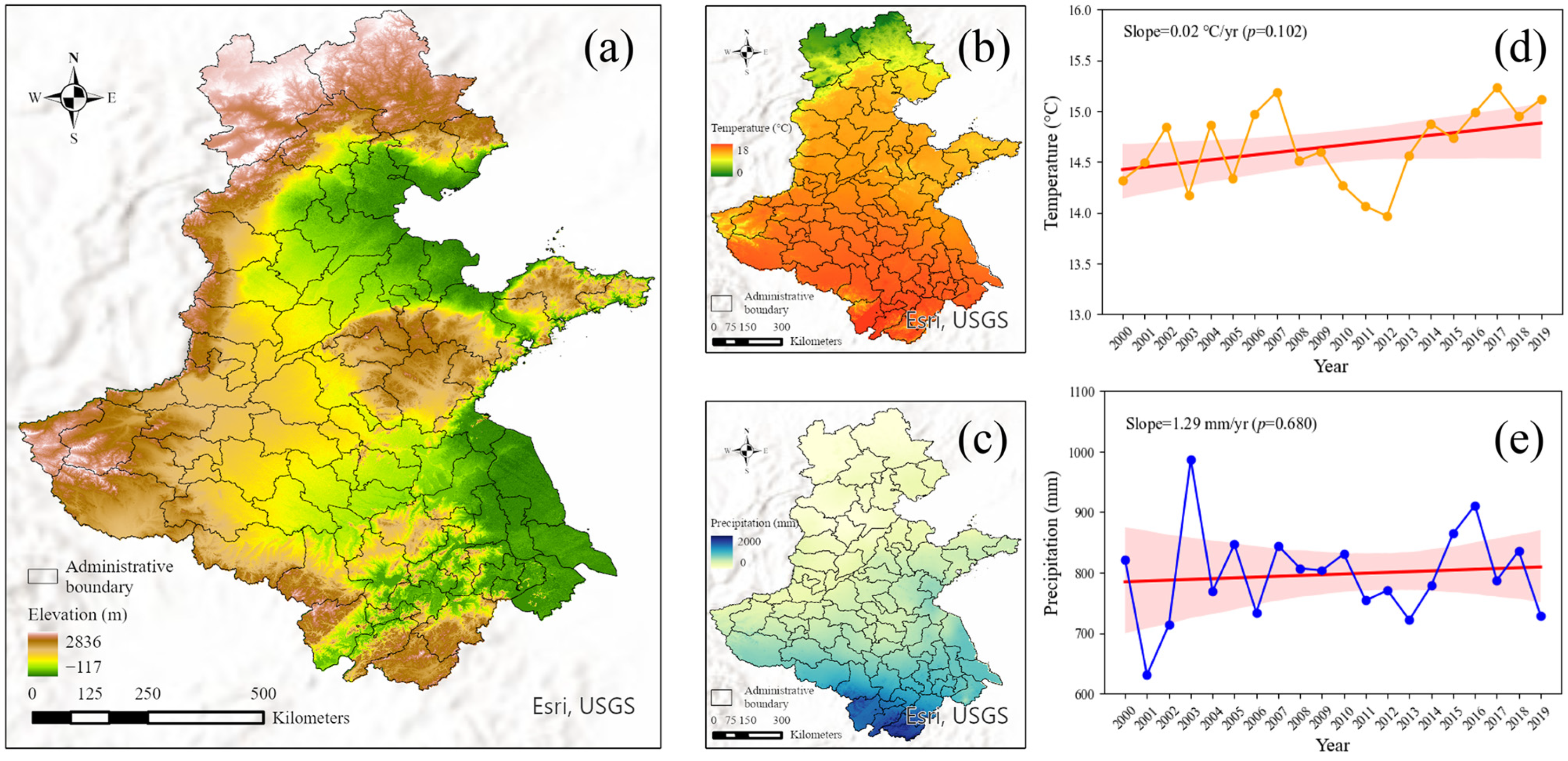

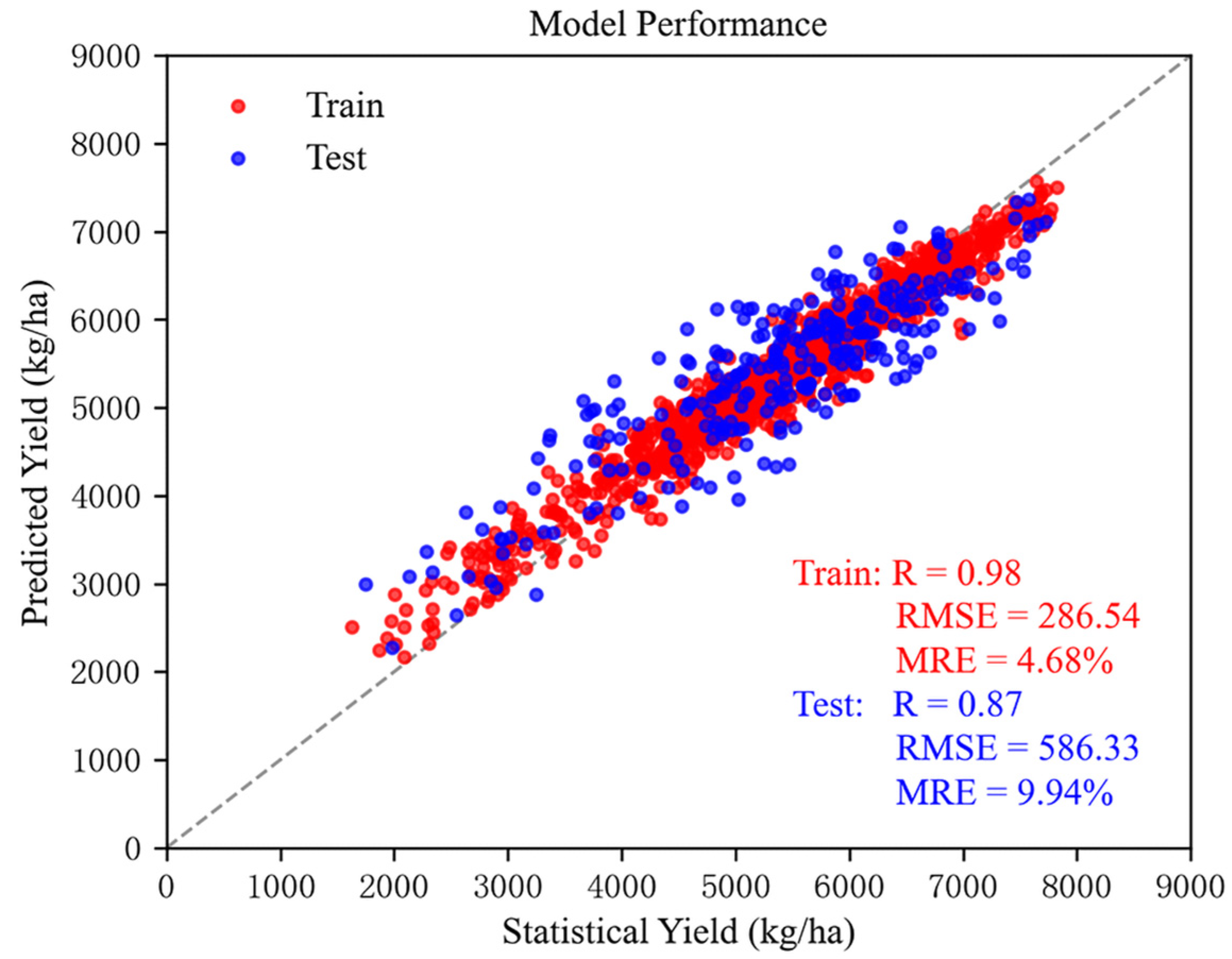
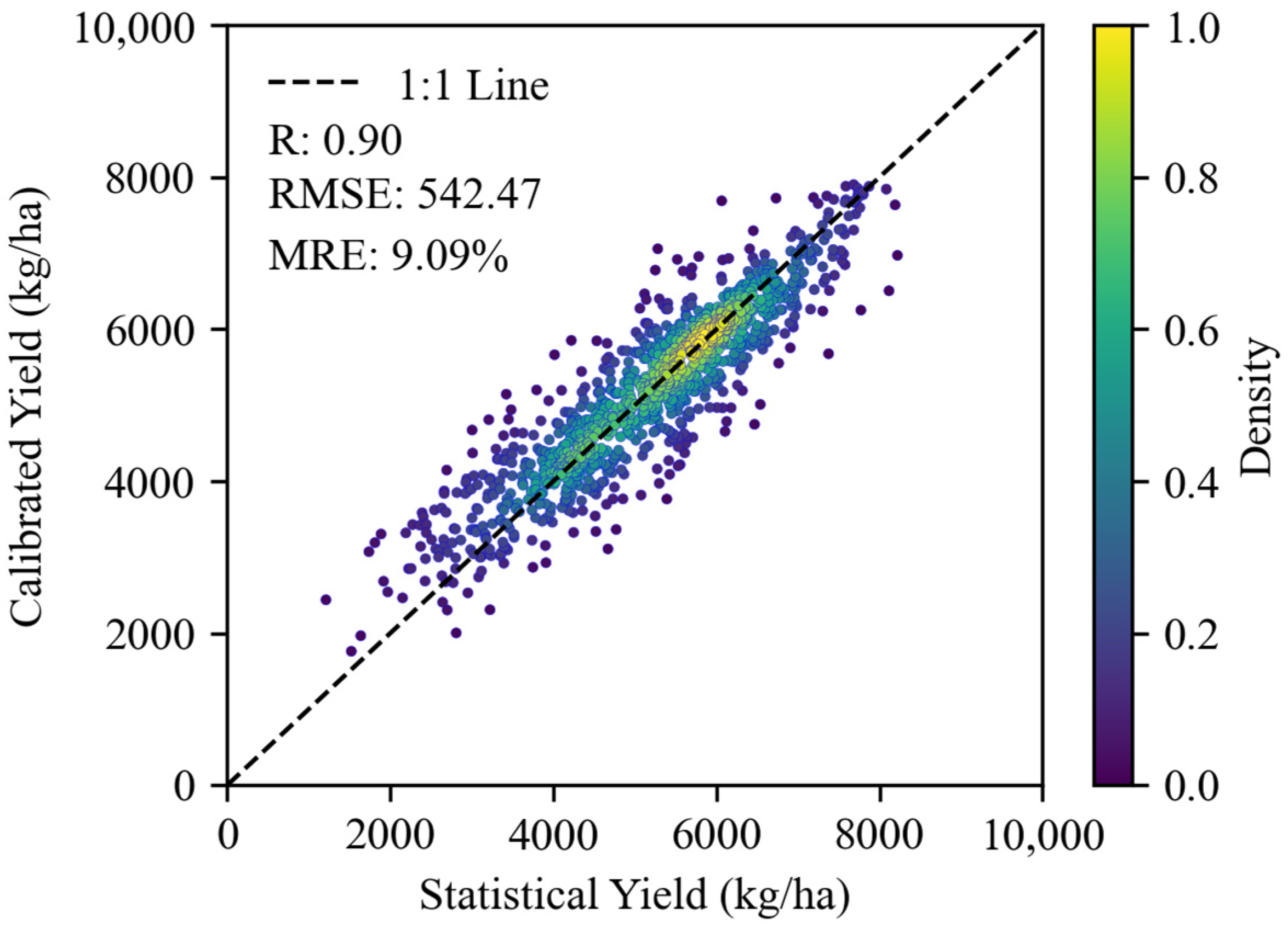

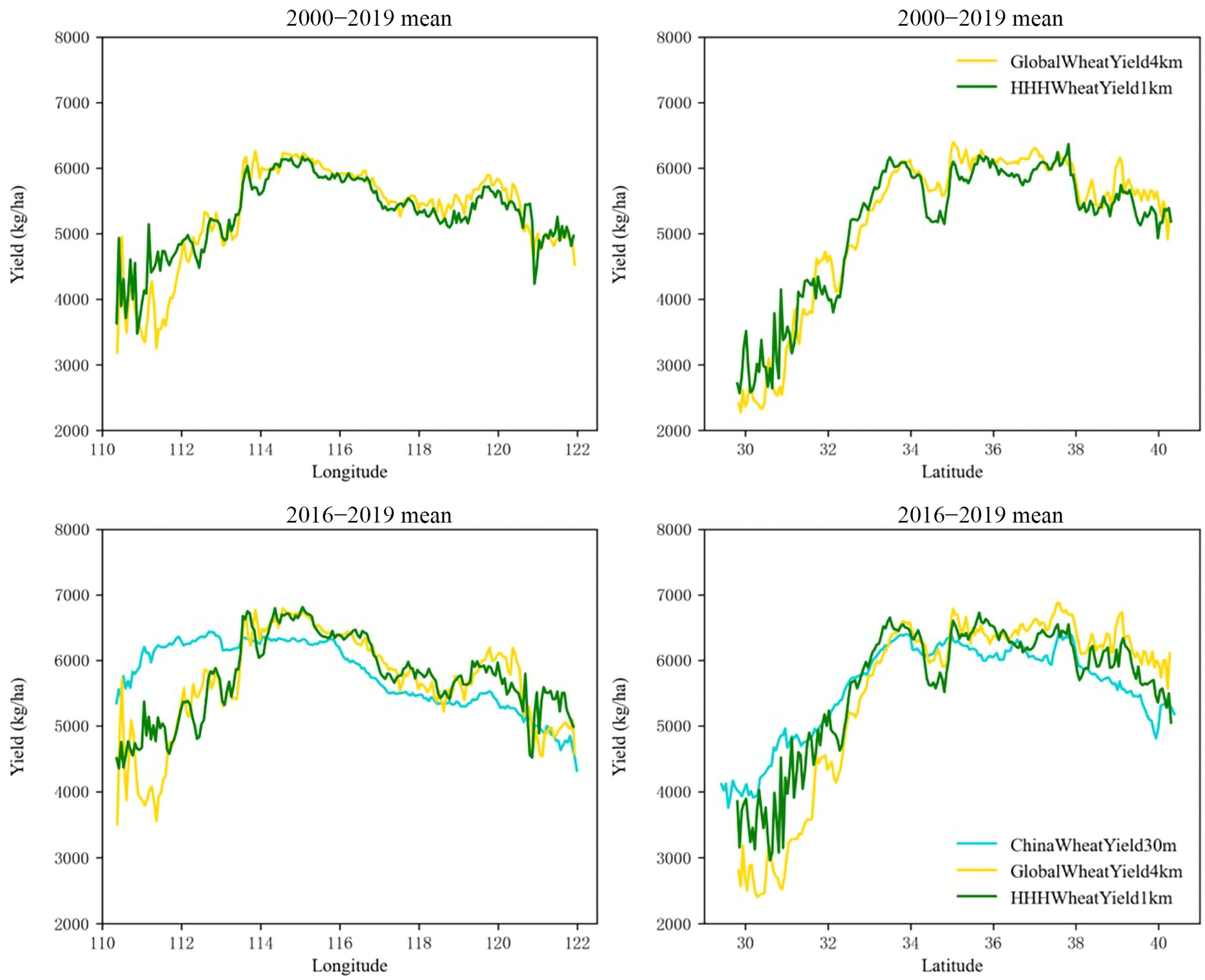


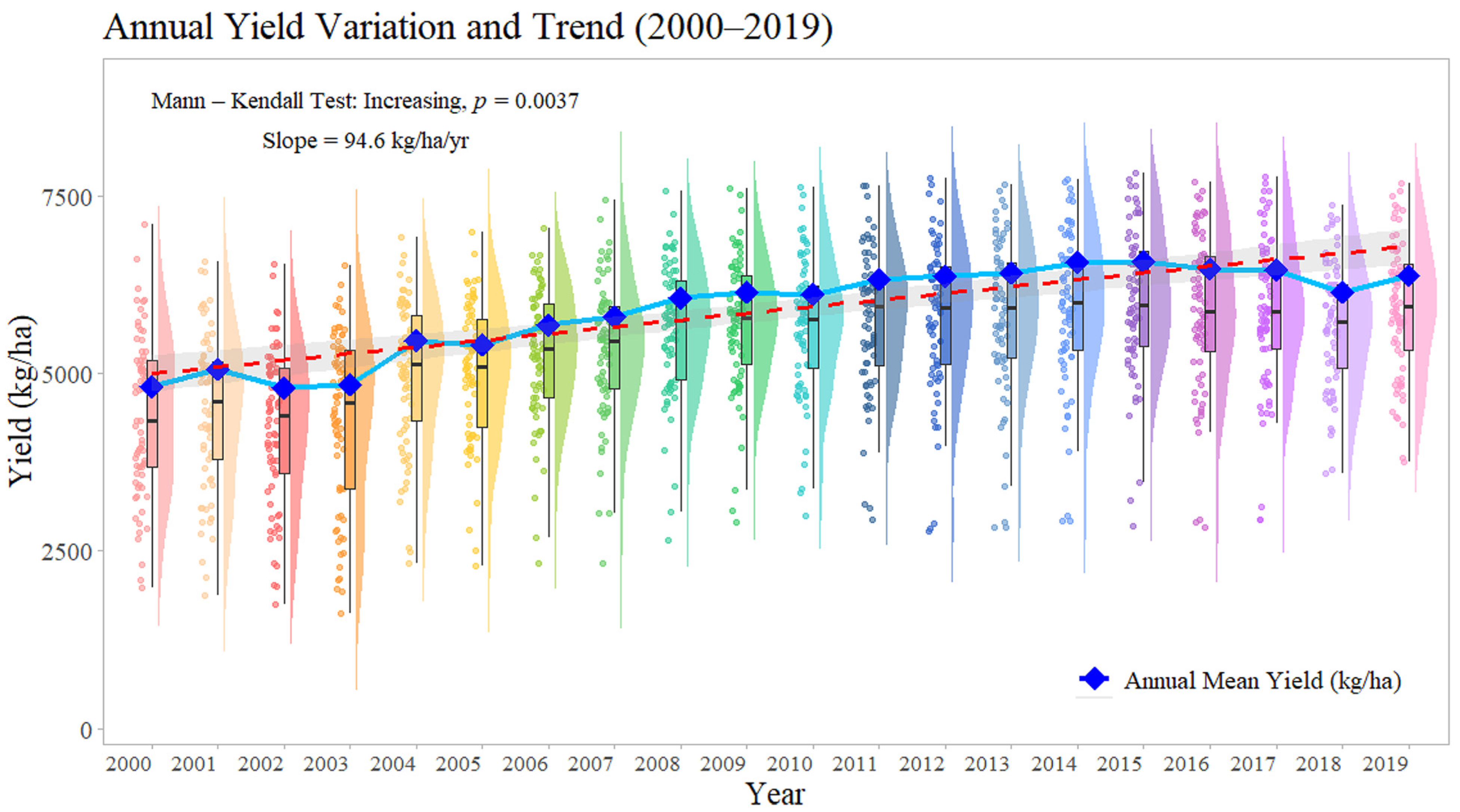
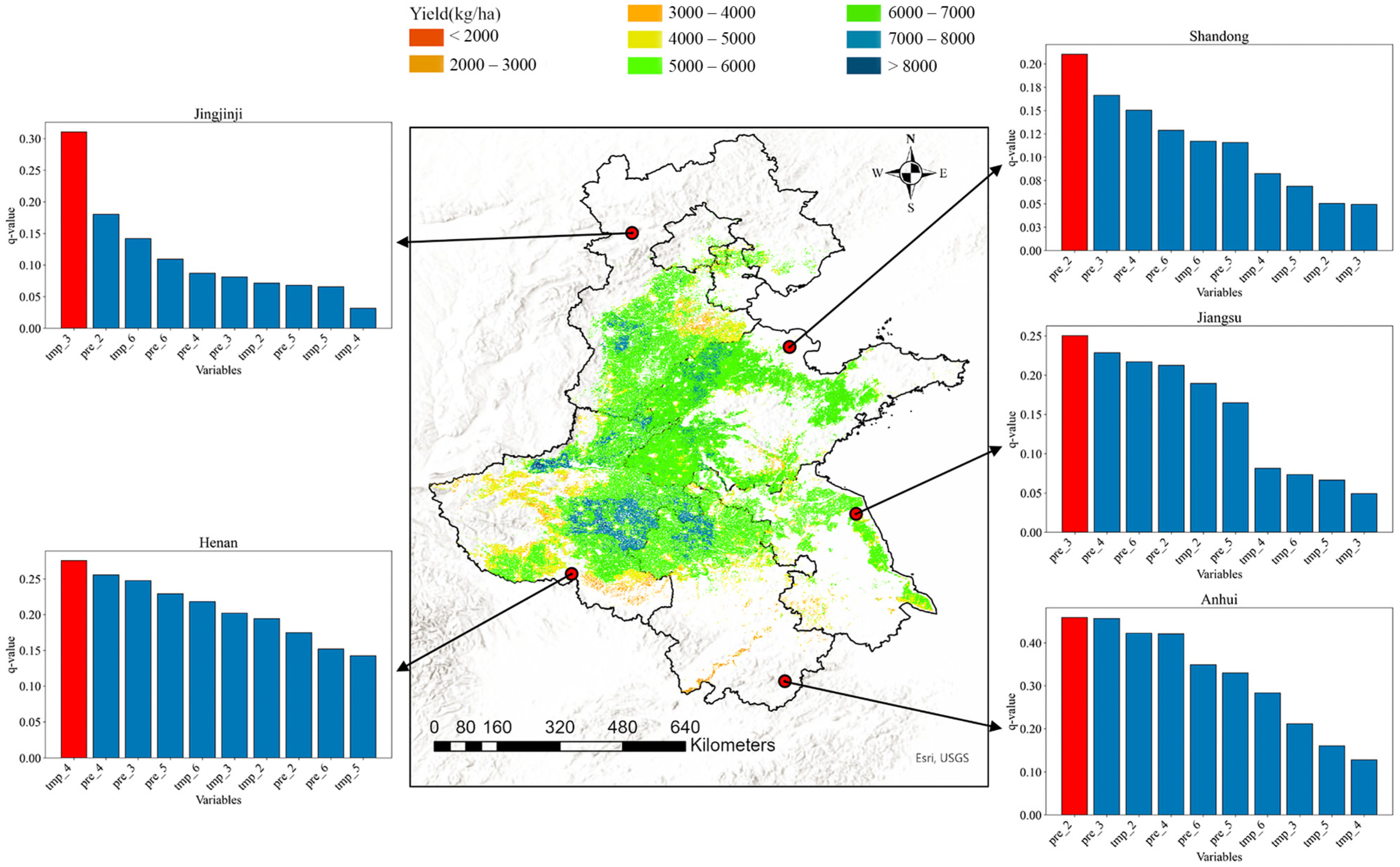


| Indices | Formulation | Reference |
|---|---|---|
| NDVI | [57] | |
| EVI | [58] | |
| EVI2 | [59] | |
| NDWI | [60] | |
| NIRv | [61] |
| Dataset | Region | Spatial Resolution | Temporal Coverage |
|---|---|---|---|
| GlobalWheatYield4km | Global | 4 km | 1982–2020 |
| ChinaWheatYield30m | China | 30 m | 2016–2021 |
| HHHWheatYield1km | Huang-Huai-Hai Plain | 1 km | 2000–2019 |
Disclaimer/Publisher’s Note: The statements, opinions and data contained in all publications are solely those of the individual author(s) and contributor(s) and not of MDPI and/or the editor(s). MDPI and/or the editor(s) disclaim responsibility for any injury to people or property resulting from any ideas, methods, instructions or products referred to in the content. |
© 2025 by the authors. Licensee MDPI, Basel, Switzerland. This article is an open access article distributed under the terms and conditions of the Creative Commons Attribution (CC BY) license (https://creativecommons.org/licenses/by/4.0/).
Share and Cite
Zhao, Y.; Du, X.; Li, Q.; Zhang, Y.; Wang, H.; Wang, Y.; Xu, J.; Xiao, J.; Shen, Y.; Dong, Y.; et al. Mapping and Analyzing Winter Wheat Yields in the Huang-Huai-Hai Plain: A Climate-Independent Perspective. Remote Sens. 2025, 17, 1409. https://doi.org/10.3390/rs17081409
Zhao Y, Du X, Li Q, Zhang Y, Wang H, Wang Y, Xu J, Xiao J, Shen Y, Dong Y, et al. Mapping and Analyzing Winter Wheat Yields in the Huang-Huai-Hai Plain: A Climate-Independent Perspective. Remote Sensing. 2025; 17(8):1409. https://doi.org/10.3390/rs17081409
Chicago/Turabian StyleZhao, Yachao, Xin Du, Qiangzi Li, Yuan Zhang, Hongyan Wang, Yunzheng Wang, Jingyuan Xu, Jing Xiao, Yunqi Shen, Yong Dong, and et al. 2025. "Mapping and Analyzing Winter Wheat Yields in the Huang-Huai-Hai Plain: A Climate-Independent Perspective" Remote Sensing 17, no. 8: 1409. https://doi.org/10.3390/rs17081409
APA StyleZhao, Y., Du, X., Li, Q., Zhang, Y., Wang, H., Wang, Y., Xu, J., Xiao, J., Shen, Y., Dong, Y., Hu, H., Yan, S., & Gong, S. (2025). Mapping and Analyzing Winter Wheat Yields in the Huang-Huai-Hai Plain: A Climate-Independent Perspective. Remote Sensing, 17(8), 1409. https://doi.org/10.3390/rs17081409






